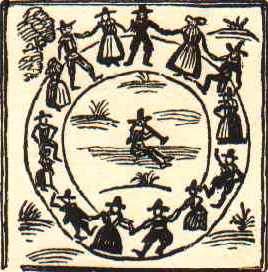Witches and King James
Witch-hunting was a respectable, moral, and highly intellectual pursuit through much of the fifteenth, sixteenth and seventeenth centuries. However, though thousands of witches were burned on the Continent, relatively few witches were executed during Elizabeth's reign--as in so many things, she avoided extremes.
But King James (who came to the throne in 1603, and who claimed to be descended from Banquo) took a special interest in the subject. In 1597 he published a book that he had written on the subject of witchcraft, his Daemonologie. In this work, James put the traditional arguments in favour of a belief in witchcraft, and his lifelong interest in the subject is evidenced by the fact that he himself participated in a number of trials of alleged witches.
From the Daemonologie
In the dialogue, the authority-figure, Epistemon, explains
what kinds of "unlawful charms, without natural causes" are
to be considered witchcraft:
I mean by such kind of charms as commonly daft wives use, for healing of forspoken [bewitched] goods, for preserving them from evil eyes, by knitting . . . sundry kinds of herbs to the hair or tails of the goods; by curing the worm, by stemming of blood, by healing of horse-crooks, . . . or doing of such like innumerable things by words, without applying anything meet to the part offended, as mediciners do.
The crucial test is that the charm works at a distance, unlike accepted medicine; it is witchcraft even when its purpose is good. In all fairness, it seems likely that by the time Macbeth was written James had become rather more skeptical; he continually warned his judges not to allow themselves to be deceived.
James saw Macbeth, and some parts of the play were designed to be complimentary to him*, so it is inevitable that Shakespeare had his views in mind as he was writing.
Footnotes
-
Playing up to James
While Malcolm and Macduff are in the English Court, discussing the state of Scotland, an anonymous Doctor enters, for no particular reason. Malcolm asks: "Comes the King forth, I pray you?" and the Doctor replies that the King (historically Edward the Confessor, but also referring to James) is coming to cure a "crew of wretched souls" from the disease known as the "king's evil," because it could be cured by the mere touch of the king.
(Of course something so miraculous was by no means witchcraft, though unexplained by normal means. The tradition of touching for scrofula continued for many years--Samuel Johnston was touched for it when a child.)
